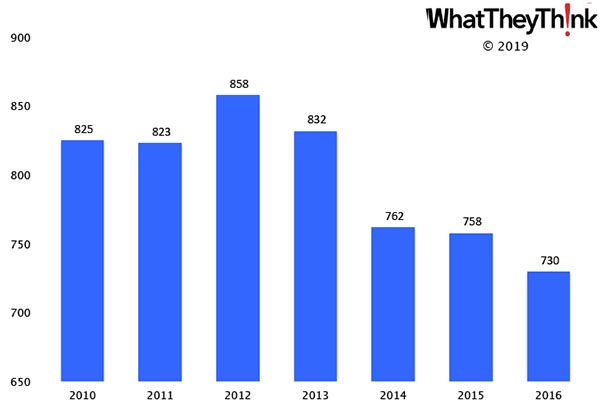
In our ongoing, semi-weekly look at establishment and employee counts of graphic arts businesses, we have been looking at packaging/paper converting establishments. Two weeks ago, we looked at NAICS 32222 (Paper Bag and Coated and Treated Paper Manufacturing), specifically, the number of establishments by employee size in 2016, the most recent year for which County Business Patterns has data (but see note at the end of this article). This week, we take a historical look at 32222. In 2010, there were 825 establishments in NAICS 32222, but by 2016, that number had declined -12% to 730, although there had been a jump in establishments from 2011 to 2012. However, bear in mind that there are so few manufacturers in this category that a 12% drop translates to less than 100 establishments.
Some of the factors driving this market segment include:
- The growing war against plastic—municipalities and states are banning plastic bags which works in paper bags’ favor.
- Growth of reusable bags affecting both plastic and paper bags.
- Trends in retail trickle down to affect demand for bags—shift to ecommerce reduces demand, but there is still demand for niche/boutique bags.
- Digital printing can eliminate the “blank bag,” while laminates, coatings, and embellishments increase strength and aesthetic appeal.
NAICS 3222 comprises some widely disparate sub-categories:
- 32221 Paperboard Container Manufacturing
- 322211 Corrugated and Solid Fiber Box Manufacturing
- 322212 Folding Paperboard Box Manufacturing
- 322219 Other Paperboard Container Manufacturing
- 32222 Paper Bag and Coated and Treated Paper Manufacturing
- 322220 Paper Bag and Coated and Treated Paper Manufacturing
- 32223 Stationery Product Manufacturing
- 322230 Stationery Product Manufacturing
- 32229 Other Converted Paper Product Manufacturing
- 322291 Sanitary Paper Product Manufacturing
- 322299 All Other Converted Paper Product Manufacturing
These different sub-categories have different market dynamics—corrugated and folding cartons vs. things like stationery—but if there is one constant across each of these categories it is consolidation. Especially in the period during and following the Great Recession (the first half of the decade), we saw no small amount of consolidation in all corners of the paper, converting, and printing industries.
These establishment counts are based on data from the Census Bureau’s County Business Patterns. These data, like other demographic data, can be used not only for business planning and forecasting, but also sales and marketing resource allocation.
Data Update: The new County Business Patterns, which includes the 2017 reference year, will be released later this month. We will be updating our data series over the next several months.









